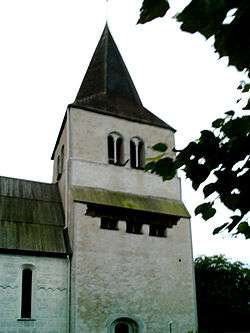Eskelhem
| Eskelhem | |
|---|---|
|
Eskelhem Church | |
 Eskelhem | |
| Coordinates: 57°29′22″N 18°12′35″E / 57.48944°N 18.20972°ECoordinates: 57°29′22″N 18°12′35″E / 57.48944°N 18.20972°E | |
| Country | Sweden |
| Province | Gotland |
| County | Gotland County |
| Municipality | Gotland Municipality |
| Area[1] | |
| • Total | 37.78 km2 (14.59 sq mi) |
| Population (2014)[2] | |
| • Total | 729 |
| Time zone | CET (UTC+1) |
| • Summer (DST) | CEST (UTC+2) |
Eskelhem is a settlement on the Swedish island of Gotland. The area is rural with farms.[3] Formerly a socken,[4] on 1 January 2016, it was reconstituted into the administrative area Eskelhem District.[5]
Geography
Eskelhem is the name of the socken, now district. It is also the name of the small village surrounding the medieval Eskelhem Church,[6] sometimes referred to as Eskelhem kyrkby. It is in the west part of central Gotland, south of Visby. The area consists of a farmed plain surrounded by forests.[3][7] The area of the socken is 37.78 km2 (14.59 sq mi) of which 37.62 km2 (14.53 sq mi) is land.[1]
History
The earliest archaeological finds in Eskelhem are remains of Stone Age settlements. There are also several Bronze Age grave mounds and cairns. The most significant find, a Bronze Age horse harness, was made in a mound by the rectory. Sixteen grave fields and three hillforts from the Iron Age are within the boundaries of the socken.[7][8][9] Stones with grind grooves have also been found.[10] A total of about 600 acheaological sites have been found at Eskelhem.[3]
The history of the present-day locality goes back to the Middle Ages. It is referred to in Medival rune inscription as yskilaim. The meaning of the first part of the name is unclear and the last part haim or hem means "dwelling", "farm" or in this case "settlement".[11]
In 1897, a railway was built from Klintehamn to Romakloster for transporting sugar beets to the sugar refinery in Roma. One of the stations along that line was Tjuls in Eskelhem, where a station house was built. The station was in use until 1953, when the passenger service on the line ceased. During that time, five station masters, three of which were women, served at Tjuls. The railway continued in operation for goods traffic until 1960. Today, the station house is a small railway museum.[12][13]
References
- 1 2 "Eskelhem socken". Svensk uppslagsbok (2 ed.). Malmö: Förlagshuset Norden. 1947–55. LIBRIS 11112.
- ↑ "Gotland i siffror" [Gotland in numbers]. www.gotland.se. Gotland Municipality. Retrieved 9 May 2016.
- 1 2 3 "Eskelhem". www.ne.se. Nationalencyklopedin. Retrieved 9 May 2016.
- ↑ The exact extent of the socken, now district, can be obtained by clicking on Kartinställningar and check the Socken box in the menu of this map from the Swedish National Heritage Board database.
- ↑ "Förordning om district" [Regulation of districts] (PDF). Ministry of Finance. 17 June 2015. Retrieved 9 May 2016.
- ↑ Lagerlöf, Erland; Svahnström, Gunnar (1973). Gotlands kyrkor (in Swedish). Uddevalla: Rabén & Sjögren. pp. 128–130. ISBN 91-29-41035-5. LIBRIS 7232718.
- 1 2 Sjögren, Otto (1931). Sverige geografisk beskrivning del 2 Östergötlands, Jönköpings, Kronobergs, Kalmar och Gotlands län. Stockholm: Wahlström & Widstrand. LIBRIS 9939.
- ↑ "Eskelhem". www.fmis.raa.se. Swedish National Heritage Board. Retrieved 9 May 2016.
- ↑ "Go, Eskelhem socken". www.historiska.se. Swedish History Museum. Retrieved 9 May 2016.
- ↑ "List of Gotland grinding grooves DE". www.stavgard.com. Sören Gannholm. 27 June 2015. Retrieved 9 May 2016.
- ↑ Wahlberg, Mats, ed. (2003). Svenskt ortnamnslexikon. Uppsala: Institutet för språk och folkminnen. ISBN 91-7229-020-X. LIBRIS 8998039.
- ↑ Enderborg, Bernt. "Tjuls järnvägsstation" [Tjuls railway museum]. www.guteinfo.com. Guteinfo. Retrieved 10 May 2016.
- ↑ "Tjuls Järnvägsmuseum" [Tjuls railway museum]. www.gotland.net. Gotlands Media AB. Retrieved 10 May 2016.
External links
| Wikimedia Commons has media related to Eskelhem. |

